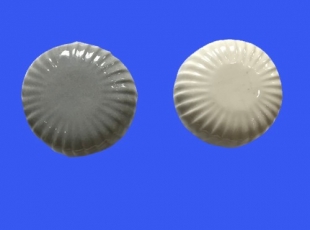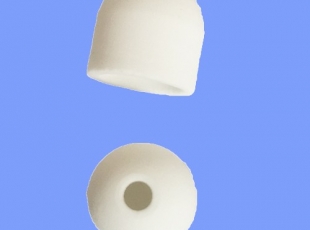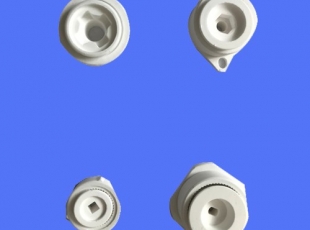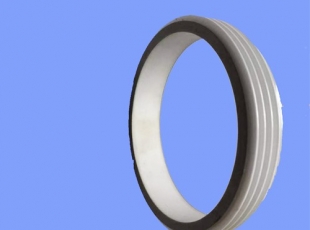What are the preparation methods of alumina ceramics?
Preparation of alumina ceramics
1. Preparation of powder
Aluminum oxide powder is prepared into powder materials according to different product requirements and different molding processes. If the particle size of the powder is less than 1 μ m, in addition to the purity of 99.99% of alumina, it is necessary to ultrafine and make its particle size distribution uniform. When extrusion molding or injection molding is adopted, binder and plasticizer shall be introduced into the powder, generally thermoplastic or resin with weight ratio of 10-30%. Organic binder and alumina powder shall be evenly mixed at 150-200 ℃ to facilitate molding operation
The raw materials of powder formed by hot pressing process do not need to add binder. If semi-automatic or full-automatic dry compression molding is adopted, the powder has special process requirements. It needs to be treated by spray granulation to make it round and spherical, so as to improve the fluidity of powder and facilitate the automatic filling of mold wall in molding.
When the powder is to be dry pressed, spray granulation is needed, and polyvinyl alcohol is used as binder. In recent years, a kind of water-soluble paraffin developed by a research institute in Shanghai has been used as the binder of Al2O3 spray granulation, which has good fluidity under heating. The powder after spray granulation must have good fluidity, loose density, and friction temperature of flow angle less than 30 ℃. In order to obtain a higher density of green billets, the particle ratio is ideal.
2. Forming method
The forming methods of alumina ceramic products include dry pressing, grouting, extrusion, cold isostatic pressing, injection, casting, hot pressing and hot isostatic pressing. In recent years, many molding technologies have been developed at home and abroad, such as pressure filtration molding, direct solidification molding, gel casting, centrifugal grouting molding and solid free molding. Different products with different shapes, sizes, complex shapes and precision need different forming methods.
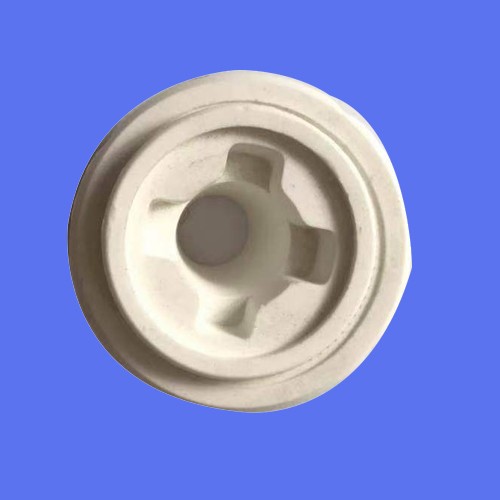
2.1 dry pressing
The dry pressing technology of alumina ceramics is limited to the objects with simple shape, inner wall thickness of more than 1mm, and the ratio of length to diameter of less than 4:1. The forming methods are single axial or two-way. There are two types of press, hydraulic and mechanical, which can be semi-automatic or full-automatic forming. The upper pressure limit of the press is 200MPa, and the output can reach 15-50 pieces per minute.
Because the stroke pressure of hydraulic press is even, the height of pressing parts is different when the filling of powder is different. However, the applied pressure of mechanical press changes with the amount of powder filling, which is easy to cause the difference of size shrinkage after sintering and affect the product quality. Therefore, the uniform distribution of powder particles in the process of dry pressing is very important for mold filling. Whether the filling quantity is accurate or not has a great influence on the dimensional accuracy control of alumina ceramic parts. The free flow effect of the powder particles is more than 60 μ m and between 60 and 200 mesh, and the pressure forming effect is better.
2.2 grouting forming method
Injection molding is an earlier molding method for alumina ceramics. Due to the use of gypsum mold, low cost and easy to form large-scale, complex shape parts, the key to the injection molding is the preparation of alumina slurry. Usually, water is used as the flux medium, and then glue dissolving agent and binder are added. After full grinding, air is exhausted, and then poured into the gypsum mold. Because of the absorption of water by the capillary of gypsum mold, the slurry is solidified in the mold. During hollow grouting, when the adsorbed slurry on the formwork wall reaches the required thickness, the excess slurry shall be poured out. In order to reduce the shrinkage of green body, high concentration slurry should be used as much as possible.
In addition, organic additives should be added to the alumina ceramic slurry to form a double electric layer on the surface of the slurry particles so that the slurry can be stably suspended without precipitation. In addition, vinyl alcohol, methylcellulose, alginate amine and other binders, polypropylene amine, Arabic gum and other dispersing agents should be added to make the slurry suitable for grouting and molding.
3. Firing technology
The technical method of densifying granular ceramic body and forming solid materials is called sintering. Sintering is the method of removing the void between the particles in the body, removing a small amount of gas and impurities and organic matters, so that the particles grow and combine with each other to form new substances.
The electric furnace is widely used in the heating device for firing. In addition to atmospheric pressure sintering, that is, pressureless sintering, there are also hot pressing sintering and hot isostatic pressing sintering. Although the continuous hot pressing sintering can increase the output, the cost of equipment and mould is too high. In addition, due to the axial heating, the length of products is limited. The high temperature and high pressure gas is used as the pressure transfer medium in the hot isostatic pressure sintering, which has the advantages of uniform heating in all directions, and is very suitable for the sintering of complex shaped products. Due to the uniform structure, the properties of the material are 30-50% higher than that of cold pressed sintering. It is 10-15% higher than that of conventional hot pressing sintering. In addition, microwave sintering, arc plasma sintering and self propagating sintering are also under development.
4. Finishing and packaging process
Some alumina ceramics need to be finished after sintering. If it is used as artificial bone, it requires high surface finish, such as mirror surface, to increase lubricity. Due to the high hardness of alumina ceramic material, it is necessary to finish it with harder grinding and polishing brick material. Such as SiC, B4C or diamond. It is usually used to grind from coarse to fine abrasive and then polish the surface. Generally, Al2O3 powder or diamond paste of < 1 μ M can be used for grinding and polishing. In addition, the laser processing and ultrasonic processing grinding and polishing methods can also be used. Some alumina ceramic parts need to be sealed with other materials.
5. Strengthening process of alumina ceramics
In order to enhance the mechanical strength of alumina ceramics, a new strengthening process of alumina ceramics was developed abroad. The process is novel and simple. The technical means adopted is to use the methods of electron ray vacuum coating, sputtering vacuum coating or chemical vapor deposition on the surface of alumina ceramics, to coat a layer of silicon compound film, and heat treatment at 1200 ℃ ~ 1580 ℃ to toughen alumina ceramics.
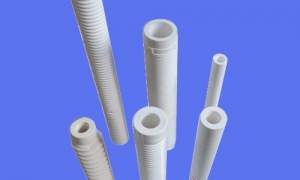
What are the sintering and functions of alumina ceramics?
The strength of alumina ceramics is only a millionth different from that of diamond. However, if alumina ceramics and wear-resistant steel, or stainless steel plates are used to develop wear resistanc...
Time of publication:2019-12-19
Changes of alumina ceramic structure at high temperature
Alumina ceramics is a kind of ceramics with alumina as the core, which is characterized by super high hardness, light weight, high heat conduction, high brittleness and wear resistance. Because cerami...
Time of publication:2019-12-18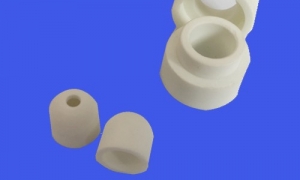
Toughening technology of alumina ceramic ring
Toughening technology of alumina ceramic ringMetal materials are easy to produce plastic deformation, because the metal bond is not directional. In ceramic materials, the bond between atoms is covalen...
Time of publication:2019-12-14
Injection molding of alumina ceramic tube
Alumina ceramic tubes have excellent properties such as high mechanical strength, wear resistance, corrosion resistance, high temperature resistance, high thermal conductivity and resistivity. They ar...
Time of publication:2019-12-10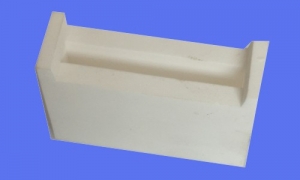
What is the difference between alumina ceramics and ordinary ceramics?
Alumina ceramic is a kind of ceramic material with alumina (Al2O3) as the main body, which is used in thick film integrated circuit. Alumina ceramics have good conductivity, mechanical strength and hi...
Time of publication:2019-12-10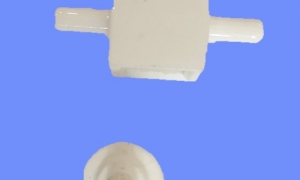
What can alumina ceramics be used for?
Application of alumina ceramics 1. Mechanical The bending strength of Al2O3 sintered products can reach 250Mpa, and that of hot pressed products can reach 500MPa...
Time of publication:2019-12-09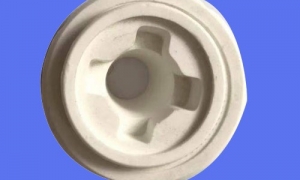
What are the preparation methods of alumina ceramics?
Preparation of alumina ceramics 1. Preparation of powderAluminum oxide powder is prepared into powder materials according to different product requirements and different molding pr...
Time of publication:2019-12-09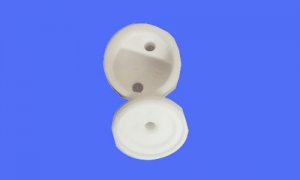
Introduction of sintering process of alumina ceramics
Introduction of sintering process of alumina ceramics 1. Atmospheric sinteringSintering at atmospheric pressure means that materials are sintered under atmospheric pres...
Time of publication:2019-12-09
Column navigation/Column menu
1What are the sintering and functions of alumina ceramics?
2019-12-19

2Changes of alumina ceramic structure at high temperature
2019-12-18

3Toughening technology of alumina ceramic ring
2019-12-14

4Injection molding of alumina ceramic tube
2019-12-10

5What is the difference between alumina ceramics and ordinary ceramics?
2019-12-10

6What can alumina ceramics be used for?
2019-12-09


